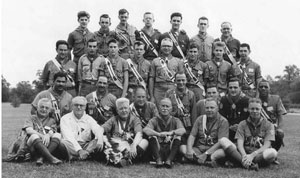 In 2014, each lodge will be asked to develop a history book as a part of the Order's ongoing legacy project. The process of researching your lodge's history might seem daunting. You might be wondering where you should start when it comes to preserving the history and traditions of your lodge. This article will give you a better idea of how your lodge can go about finding the information to include in your history book for the 2015 Legacy Project.
In 2014, each lodge will be asked to develop a history book as a part of the Order's ongoing legacy project. The process of researching your lodge's history might seem daunting. You might be wondering where you should start when it comes to preserving the history and traditions of your lodge. This article will give you a better idea of how your lodge can go about finding the information to include in your history book for the 2015 Legacy Project.
The first step should be pulling together people for a history committee in your lodge. Researching and recording your lodge's history becomes less demanding when a group of similarly focused Arrowmen are working together.
How your history committee decides to organize its book will influence how you should set up responsibilities for members of your committee. My home lodge's book is chronological so it would make sense for my lodge's history committee to have people assigned to different decades or eras of my lodge. Breaking down history into subgroups has its pros and cons. One good thing is that it becomes easier to focus on and find more in depth information when you have a smaller time span to research. However, I find it important to remember that history is a story; the subgroups all connect in some way, shape, or form.
If possible, don't reinvent the wheel. Your lodge might have previously created a history book. Whether it was written fifty years ago or five, the book is a step in the right direction. Archives can be another good source of information for your committee. Archives typically include pictures and scans that can shed light on what happened at an event. When I was looking for information for an article on the history of the five lodges that formed Kintecoying Lodge, I found a wealth of information in the Ten Mile River Museum online archives. Your lodge's website would be yet another place to look for historical information. A lot of lodges have a history section on their website which can include information such as a brief overall history, lists of past youth officers and advisers, award recipients, and more. Finding any information by these means can really help jumpstart your committee's efforts to create a history book.
If your lodge hasn't recorded too much in the past, your committee will have to turn to living history. Living history comes in all ages and varying knowledge levels depending on what years you ask them about. First hand sources are not always the most reliable, so I recommend you run insights by multiple people in order to confirm a piece of information. Interviews do not have to be formal. Sometimes you can learn the most by just sitting down and listening to stories.
Newer history is easier to research because it is fresh in the minds of those around you. More attention will have to be put on to the history from the earlier years and thus more Arrowmen should be assigned to that time frame. It is important to coordinate progress between members of your committee. Ask "what has been found, and what do we still need to figure out?"
Do not be afraid to put out blurbs in publications. Blurbs can be broad or very specific you could ask for information from the sixties or you can ask for information pertaining to your lodge's fellowship in 1964. You never know who might come forth with information or a lead. For example, I recently put a few sentences into my lodge's newsletter asking for materials that I could scan for a lodge archive and got a few leads as to where I could find documents. Go into detail when you are able. I find it more interesting to read a bio about a past lodge chief rather than merely seeing their name in a long list of past lodge chiefs. Bring your lists to life whether they are of past award recipients or of officers. Details can go a long way to inspire members of your lodge to give more cheerful service.
Create a standing history committee instead of a special history committee. It is far easier to have a more complete history if the book is updated as it happens.
The National Subcommittee on Recognition, Awards, History and Preservation has assembled a very helpful instructional document which goes into further detail on the lodge history book project, including sample histories on which you can model your own lodge's book. In the near future, the National Order of the Arrow Web Site will be posting a number of helpful resources as you move forward with this undertaking. I hope you have fun with this very important project and learn a lot in the process. Together you and your committee can share the legacy of those that came before you, and in doing so, leave your own.